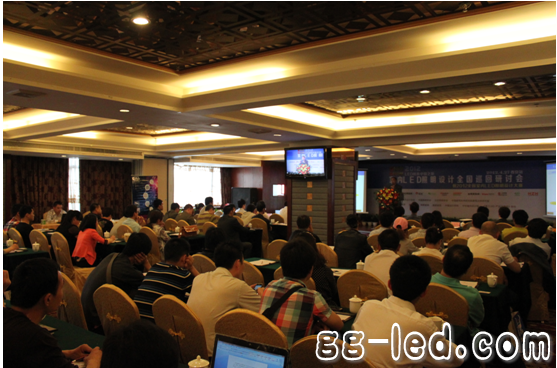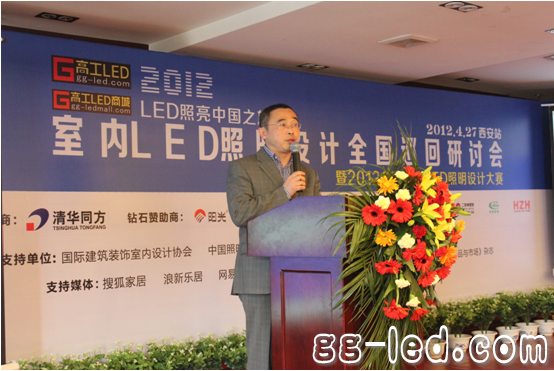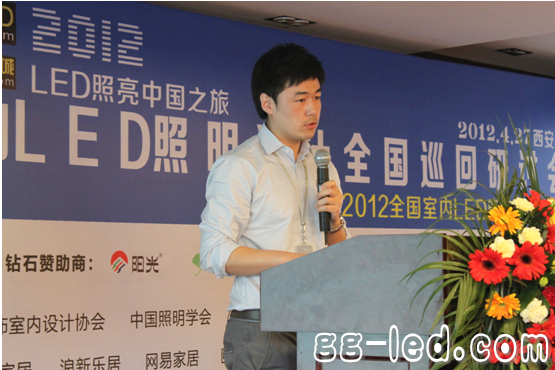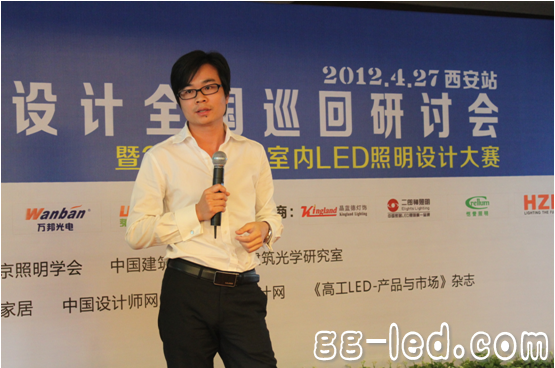On April 27th, Xi'an Station, the second stop of Gaogong LED Lighting Design National Touring Symposium, was held as scheduled in the multi-functional conference hall on the 3rd floor of Xi'an Yanta International Hotel. More than 150 people from representatives of local distributors in Xi'an, representatives of engineering companies, designers and representatives of LED brand companies across the country attended the seminar.


Mr. Li Yi, Director of Vanke Times, Xi Jin, Director of Chang'an University Decorative Design Institute, Mr. Li Jiemin, Deputy Chief Engineer of Huazhao Technology, Mr. Xie Xiaopei, General Manager of Yu Yu Lighting, Mr. Tan Jian, General Manager of Laiwei Optoelectronics, and Product Manager of Tsinghua Tongfang Mr. Zhiwei, Mr. Li Jinfeng, Director of Matsushita Electric Lighting EC Division, Mr. Zhang Dongyuan, Assistant Chairman of Wanbang Optoelectronics, and Dr. Zhang Xiaofei, Director of Gaogong LED Industry Research Institute, attended the meeting and delivered important speeches.

Dr. Zhang Xiaofei, Director of the High-tech LED Industry Research Institute: The Way of LED Channel Construction (Channel is King)
Zhang Xiaofei mentioned that in 2011, the output value of LED indoor lighting was 18.6 billion yuan, and the output value of outdoor lighting was 5.1 billion yuan, with a growth rate of more than 35%. In the next few years, the average annual growth is expected to exceed 40%. By 2015, the penetration rate of LED general lighting is expected to reach 19%, and by 2020 it will reach 70%. LED lighting will replace and surpass traditional lighting. Enterprises, distributors and even designers need to establish their own LED lighting channel system as soon as possible.

Mr. Lu Zhiwei, Product Manager of Tsinghua Tongfang: Application of LED products in restaurants
Mr. Lu Zhiwei proposed that the restaurant lighting design needs to meet the requirements of “Architectural Lighting Design Standard GB50034â€. Designers need to combine regional style and cuisine characteristics, highlight individuality design, and be flexible; the light source and interior style should be highly coordinated, and the contrast between light and dark is obvious. To meet the customer's emotional characteristics; in the choice of lighting, choose high color rendering (Ra> 85), low color temperature (<3300K), light distribution, multi-function, compact and easy to hide lamps. Through actual cases, it can be seen that LED lighting has many advantages in restaurants: high efficiency and energy saving, more than twice energy saving; variable color, creating a flexible and varied indoor environment; easy to install and hide, to achieve the effect of seeing no light; long life Reduce maintenance costs.

Mr. Tan Jian, General Manager of Laiwei Optoelectronics: The focus of LED lighting development in the future lies in design
Mr. Tan Jian believes that LED lighting companies can not find dealer agents, in addition to price, technology and other factors, but also related to dealers' lack of understanding of LED lighting products, they do not know what is called light effect, what is the angle of illumination, what is lumen Maintenance rate. Their LED products can't move consumers, and the company's LED products can't move the dealers. To promote LED lighting on a large scale, it is necessary to deepen the dealer's understanding of LED lighting products.
At present, the price of LED lighting products can be very low, which provides the necessary conditions for the scale of LED lighting in the field of indoor lighting. With the continuous entry of international manufacturers, the quality of lamps will become increasingly mature. In view of the current LED lighting products, the serious phenomenon of plagiarism, I believe that the future development of LED lighting will be transferred to the design of LED lighting, if the company does not have personalized design support, it will be difficult to survive in the future.

Mr. Li Yi, Director of Vanke Times: Both quality and after-sales
Mr. Li Yi mentioned that the current domestic LED indoor lighting is still in its infancy, the various technologies are not mature enough, and the product quality is also uneven. As a lighting engineering company, it is an important bridge connecting companies and customers. We value the market potential of LEDs and believe that LED new light sources will replace traditional lighting. We need high-quality LED lighting source for engineering design, and we need to provide perfect after-sales service to reduce post-maintenance costs, but we still have no guarantee.
In the next three years, it will be the growth period of LED indoor lighting. The application of LED in indoor lighting will surely enter a new stage. In addition to providing quality products, enterprises also need to provide comprehensive after-sales service to avoid the worries of customers.

Antenk DVI Series Digital Video Interface connectors are the standard digital interface for flat panels, video graphics cards, monitors and HDTV units. This series includes DVI-D (Digital), DVI-A (Analog) and DVI-I (Integrated Digital/Audio). Their unique crossing ground blades provide high speed performance at low cost. They are available in Straight or Right Angle PCB mount receptacles and mating male cable connectors. They support a data transfer rate of 4.95Gbps with a dielectric withstanding voltage of 500VAC. Each version features our specially designed contacts which improve signal performance and a zinc alloy shield that reduces electromagnetic interference (EMI).
Digital Visual Interface Cable Connectors
DVI ConnectorWith the advent of technologies such as DVD players, high-definition televisions, and even digital cable, the need for more advanced cables and connectors has increased. Digital Visual Interface (DVI) is one response to the growing need for interconnected systems, enabling digital systems to be connected to an array of displays. Yet DVI cables and connectors can also be complicated, and may lead to confusion between High Definition Multimedia Interface (HDMI) and DVI. Although the two systems have much in common, they service different niches of digital technology.
Digital Visual Interface
Older systems aren`t necessarily outdated systems. Although DVI preceded HDMI, it`s still widely used in both business and domestic settings. DVI connectors are designed to handle digital data transmission, incorporating three transmission channels in every connector link. The maximum bandwidth for data transfer is 165 megahertz, which is enough to relay up to 165 million pixels per second. Data is encoded for effective transfer, but a single link can handle around 4.95 gigabits per second of information. Double links can handle twice that amount.
Because a DVI cable carries information over a 165 megahertz bandwidth, complete digital resolution can be obtained. Using double link connectors increases the speed of transmission, but requires another cable. However, not many devices depend solely on a double link DVI, so this technolgy can be used on an as-desired basis.
Types of DVI Connectors
There are three general categories of DVI cable connectors: DVI-Digital (DVI-D), DVI-Integrated (DVI-I), and DVI-Analog (DVI-A). However, most connectors fall into one of the first two groups.
A standard DVI Connector is 37 mm wide and has 24 pins, 12 of which are used for a single link connection. When analog is involved, four additional pins are needed to support the additional lines of an analog signal. It is not possible to cross from a digital source to an analog display or vice versa. In those instances, an integrated connector is probably the best option. There are five common types of DVI connectors.
DVI-I Single Link
This kind of connector has three rows, each with six pins. There are two contacts. Because the connector is integrated, it can be used with both analog and digital applications.
DVI-I Dual Link
A DVI-I dual link connector can also be used with both digital and analog applications, but is configured with more pins to accommodate a dual connection. There are three rows with eight pins each, as well as two contacts.
DVI-D Single Link
Specifically designed for digital applications, a DVI-D single link connector has three rows of six pins, and looks much like a DVI-I single link connector. However, a DVI-D connector has no contacts.
DVI-D Dual Link
Also made specifically for digital applications, a DVI-D dual link features more pins (three rows of eight) for dual connections. Like a DVI-D single link, a DVI-D dual link connector has no contacts.
DVI-A
This particular type of connector can only be used for analog applications, and has three rows of pins. One row has five pins, one has four pins, and the last row has three pins. Like single link connectors, a DVI-A link connector has two contacts.
Female DVI Connector
ShenZhen Antenk Electronics Co,Ltd , https://www.pcbsocket.com